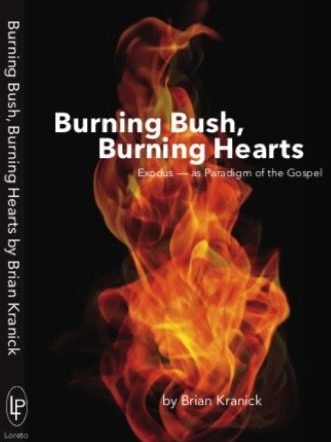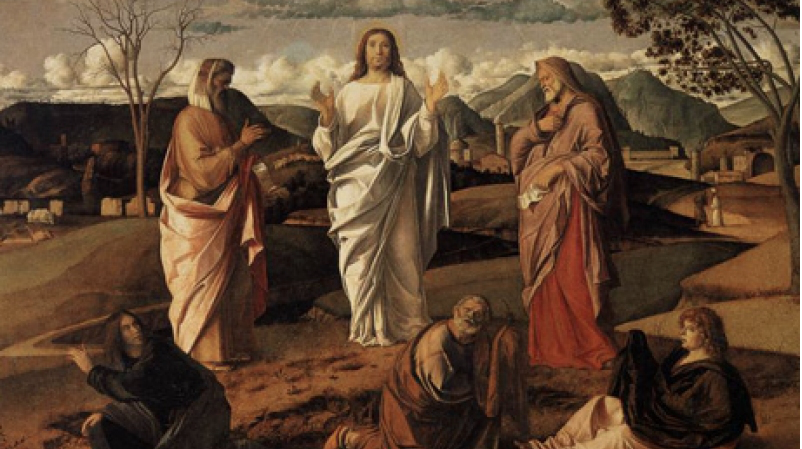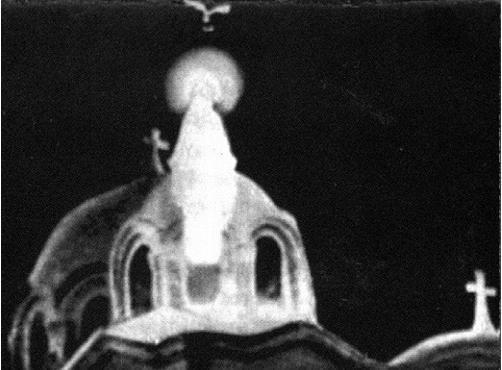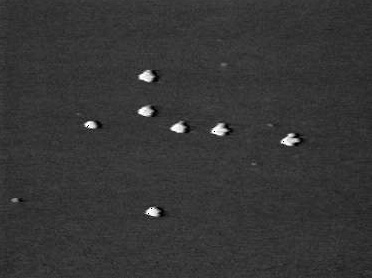Introduction

If you believed Moses, you would believe me, for he wrote of me.
—John 5:46
From Type to Reality
The heart of Exodus is the revelation of the Person of Jesus Christ. Each detail and each event of the story adds a brushstroke to the portrait of the coming Messiah that is taking shape. Hints of Christ are in the Passover, the Tabernacle, the manna, the sacrifices, the water, the fire, and the feasts. Exodus is nothing less than God’s revealed plan of redemption for our salvation.
Exodus is a series of object lessons illustrating the Catholic Church and a catechetical instruction on the Sacraments. It is the archetype for the New Covenant, the blueprint and roadmap, bursting with prefigurements that are fulfilled in Christ and his Church. Exodus is, at its core, a divine love story. It reveals God’s deep abiding love for humanity and the lengths he desired to go to save us. Thus, the story of Exodus begins with God revealing who he is to his people, and continues to the revelation of his intent for us to dwell together with him for all eternity—the marriage of God and humanity.
From Judaism to Catholicism
It all begins with the Jewish people, for as Jesus declares, “salvation is from the Jews” (John 4:22). God sets the Jewish nation apart for his special purpose in salvation history. It is a unique nation with a unique purpose and a unique destiny, and the Christian world is eternally grateful to the Jews, our elder spiritual brothers, for their role in adhering to the Torah and preparing the world for the Messiah. Although Israel failed en masse to recognize the Messiah, God has nevertheless blessed the nations of the world through ancient Judaism.
Judaism and Christianity are, in reality, not two separate religions, but two phases of one religion. They are the old church and the new church, on one linear timeline. Judaism has been fulfilled in and transformed into Catholicism.
In 1938, on the eve of World War II, with the massing of the bloody Nazi war machine and their satanic anti-Semitic designs, Pope Pius XI gave a public address at the Vatican to Belgian pilgrims declaring: “. . . it is impossible for a Christian to take part in anti-Semitism. It is inadmissible. Through Christ and in Christ, we are the spiritual progeny of Abraham. Spiritually, we are all Semites.”[1] A truer statement has never been made. Jesus was a Jew. Our faith is a Jewish faith in a Jewish man. Our religion is Judaism fulfilled.
The Catholic faith germinated in the seed of Judaism, and the seed of Judaism flowered to full growth in the Catholic Church. St. Augustine expresses this relationship between Judaism and Catholicism in a slightly different way: “the New Testament lies hidden in the Old and the Old Testament is unveiled in the New.”[2] The ancient Jewish liturgical practices gave birth to the beauty of the Catholic Church, the Sacraments, and the Mass.
God repeatedly calls each of the liturgical rites in Exodus “a statute forever.” As ancient liturgical and sacrificial Judaism has ceased to exist, a legitimate question is: Was God wrong? No, indeed, these liturgical rites have not been lost, but only transformed. The Mosaic liturgy of ancient Judaism has been carried forward and validly transformed into the liturgy and Sacraments of the greater Catholic Church.[3] Mount Sinai continues on in Mount Zion. The Tabernacle of the wilderness continues on in the tabernacle of each Catholic Church.
The Progressive Revelation of Christ
In the course of salvation history, God progressively reveals himself to Israel, particularly in the revelations to the Patriarchs Abraham, Isaac, and Jacob. This process is accelerated in the Exodus and continues throughout the Old Testament so that for millennia before the Incarnation, God has been preparing Israel and all of humanity for the arrival of his Son. This is indeed the very focus of the whole Old Testament: preparation for the Incarnation. Under the divine influence of the Holy Spirit, Moses writes the inspired story of Exodus and the rest of the Torah. The super-intellect of the Divine Being that guided Moses’ writings embedded within them signs, symbols, foreshadowings, typologies, and prefigurements of the coming of Christ. The Catechism states this plainly: “All the Old Covenant prefigurations find their fulfillment in Christ Jesus” (Catechism of the Catholic Church, no. 1223).
Scholars estimate that the Exodus happened somewhere between 1,200 to 1,500 years before the birth of Christ, probably closer to the latter date. This long lead-time of, give or take, a millennium and a half before Christ only adds to the miraculous nature of the prophetic text and speaks all the more clearly to the Torah’s divine origin. How, without divine guidance, could Moses have so accurately predicted Christ in sign and symbol so many years ahead of his life?
Types and Typologies
A hermeneutic[4] of Exodus draws out the “types” and “typologies” embedded in Scripture. Typologies are not prophetic words, but rather, prophetic actions, situations, people, events, and objects: a kind of unspoken prophecy, a symbology that manifests a future reality. These are woven into Scripture in a way that only the omnipotent mind of God could have intended. The typologies of Exodus are rich and bountiful, and along with other prefigurements in the Old Testament, they point to the coming of Jesus Christ. The “type” is the prefigurement, and the “antitype” is the fulfillment. The types in the Old Testament give way to the antitype reality in the New Testament.
Types and typologies were understood well by the Biblical writers of the New Testament and the early Church Fathers, and they are explained throughout the Gospels, the Epistles, and the early Fathers’ writings of Church Tradition. In fact, the exegesis of Scripture based upon typological interpretation has a long and deep history. Typology has been studied for two thousand years in the quest to better understand the mind of God. In other words, this is nothing new! Studying Exodus in light of Catholic Tradition is not a novel idea, but an ancient one. The brilliant St. Paul illuminates the depths of scriptural typologies in his letters, assuring us that “These are only a shadow of what is to come; but the substance belongs to Christ” (Col. 2:17).
Types and typologies of the Old Testament scriptures are “only a shadow” pointing towards Christ to come. The Catechism echoes St. Paul: “[The Paschal catechesis] is called ‘typological’ because it reveals the newness of Christ on the basis of the ‘figures’ (types), which announce him in the deeds, words, and symbols of the first covenant. By this re-reading in the Spirit of Truth, starting from Christ, the figures are unveiled” (CCC, no. 1094). The typological events of Exodus are recorded as an example for us to learn from, as St. Paul clearly discerns: “Now all these things happened to them in figure: and they are written for our correction” (1 Cor. 10:11 DRA). The word for “figure” is actually the Greek word tupos (τύπος) meaning “type.”[5] The typologies of Exodus are a snapshot of all salvation history that prophesies—through symbology—the coming of Christ and the New Covenant. It is the preview of the Redemption.
Exodus as Paradigm for the Gospel
The Exodus is to the Old Testament what the Gospels are to the New Testament. The Torah, the five books of Moses and the Law, is built around the Exodus. It is a paradigmatic text; in fact, it is the paradigm that the whole Old Testament is built upon. But Exodus is paradigmatic for the New Testament as well: the whole Gospel is patterned after the Exodus to such an extent that the Gospel could very aptly be called the “Second Exodus” or the “New Exodus.” If Genesis 3:15 is the protoevangelium,[6] Exodus is the full-fledged Old Testament Gospel. Moses is the paradigm for the Messiah, the new Moses, who will lead the greater Israel into a new Exodus. The new Exodus will be even more glorious than the original, as the remnant of Israel will be gathered together “from the four corners of the earth” (Isa. 11:12). The type is not abolished or abandoned but fulfilled. Keep in mind, there is a certain escalation that happens from the type to the fulfillment. The Exodus type always gives way to the greater, more glorious, antitype fulfillment in Christ.
Many Jews at the time of Christ lived in fervent anticipation of the imminent arrival of the Messiah. Moses himself writes about the coming Messiah who will lead Israel; as God says, “I will raise up for them a prophet like you from among their brethren” (Deut. 18:18). The arrival of St. John the Baptist as the forerunner of Christ, for example, immediately evokes the Exodus, as he is “in the wilderness” (Matt. 3:3) and baptizing at the Jordan River. The original Exodus will be a paradigm for the new Exodus under the Messiah. The Old Covenant will be fulfilled and repeated again, but on a much grander scale, in the New Covenant.
The whole Old Testament points to the Incarnation of God in both explicit prophecies and unspoken typologies. But it is specifically the unspoken symbology of Exodus, pointing always toward Christ, that is the subject of this book.
The First Level: Christological Typology
In order to understand the fulfillment of Exodus in Christ, it is necessary to understand the typological character of the text. There are three essential elements embedded in typologies: Christological, sacramental, and eschatological. The first set of typologies, the Christological, point toward the life of Christ in his First Coming, his Incarnation. These prefigure the life, Passion, death, and Resurrection of Christ in the first century A.D. in Israel, and one of the main themes running through Exodus is the typology of Christ’s First Coming in his historical life of this time and place.
The Second Level: Sacramental Typology
The next level is the typology of the seven Sacraments of the Catholic Church: Baptism, Confirmation, Eucharist, Penance, Anointing of the Sick, Matrimony, and Holy Orders. The Israelites’ journey through the desert wilderness is a sacramental journey: each miraculous event in Exodus foreshadows a supernatural Sacrament of the Catholic Church, and thus, the miraculous in the Old Covenant becomes the supernatural in the New Covenant. God telegraphs the coming of the Holy Spirit and the Sacraments by punctuating specific events in Exodus with a miracle or a miraculous appearance. The crossing of the Red Sea, the water from the rock, the manna from Heaven: in all of these, the miraculous type is fulfilled by the supernatural grace of Christ in the Church’s seven Sacraments.
In fact, the seven Sacraments are so implicit in everything that happens in Exodus that Exodus forms a microcosm of the Catholic Church and a blueprint for her Sacraments. Many of the early Church Fathers have noted that reading the typologies of Exodus is a form of catechetical instruction, and the New Testament also treats Exodus as a type of catechesis for the Sacraments. Jesus himself interprets Exodus typologically and sacramentally. In John’s Gospel, for example, he records Jesus’ Bread of Life discourse on how the manna in Exodus is fulfilled by himself as the new Eucharistic bread from Heaven. To study Exodus, therefore, is to understand the importance of the sacramental nature of the Church.
The Third Level: Eschatological Typology
The last critical element of Exodus typologies is the eschatological, or the events concerning the end of the world. Like the other typologies, these point toward Christ; but whereas the Christological typologies point toward the life of Christ in his First Coming, and the sacramental typologies point toward Christ in the Catholic Church and the Sacraments, the eschatological typologies point toward Christ in his Second Coming. The Second Coming typologies have obviously not been fulfilled yet, but they can still be discerned through New Testament writings and prophecies concerning the Parousia and the final things.
As reflections of God’s omnipotent mind, many of the events of Exodus reveal not just one typology, but multiple levels of typological interpretation. So, one event or action or object in Exodus may reflect a single typology, two typologies, or even all three typologies: the First Coming of Christ, the Second Coming of Christ, and the Sacraments.
Christ in Exodus
St. Jerome famously said, “ignorance of the Scriptures is ignorance of Christ,”[7] and in the case of Exodus, this is most profoundly true. Christ is embedded in all of the events of Exodus, and not only Christ himself, but also the Catholic Church and her seven Sacraments. This union between Christ and the Church should not surprise us. We know that the Church is the Body of Christ, and Christ is one with the Church. As Saul was attacking the early Church, the resurrected Jesus appeared to him in a blinding flash of light, asking, “Saul, Saul, why do you persecute me?” (Acts 9:4). Jesus is connected so intimately with the Church that he calls us “me.” The Catholic Church is the on-going presence of Jesus Christ in the world, and Christ is present in a very real way in the priesthood, the faithful, and in the Sacraments of the Church. The merits of Jesus’ life, Passion, death, and Resurrection have been entrusted to the Church, and his sanctifying grace is accessible to all through the Sacraments.
Reliance on God: in Exodus and in the Sacraments
One of the main underlying themes of Exodus is that the Israelites needed to have a radical dependence upon God in order to survive for the forty years of their wilderness journey. They needed these sacramental typologies, as we read them now, to physically survive and reach the Promised Land; in parallel fashion, we need the Sacraments to spirituallysurvive this life and inherit eternal life. The truth is we, too, are on an Exodus journey in the desert wilderness of this world.
The Exodus is thus a metaphor for our own journey. In the Christian era, the sacramental typologies of Exodus have given way to the actual Sacraments themselves of the Church—yet, the lesson remains the same. Just as the Israelites needed the sacramental signs to reach the Promised Land, we need the Sacraments to reach Heaven, and a reading of the sacramental typologies in Exodus reveals the absolute necessity of the Sacraments for our salvation. It is a clarion call to live a holy, set-apart life, close to the Church and close to the Sacraments so that we may remain close to Christ in our spiritual exodus, with the hope of one day reaching the eternal Promised Land of Heaven.
[1] Margherita Marchione, Yours is a Precious Witness: Memoirs of Jews and Catholics in Wartime Italy (Mahwah, NJ: Paulist Press, 1997), 53.
[2] St. Augustine, Quaestiones in Heptateuchum, 2, 73; Cf. Dei Verbum IV, 16.
[3] This includes both the Roman and Eastern Catholic liturgical rites, and the Orthodox Church. However, due to the schism with Rome, Orthodox rites are generally considered illicit for Catholics under normal circumstances according to Canon Law (Canon 844).
[4] an interpretation of Biblical texts.
[5] Strong’s Concordance.
[6] literally “first Gospel,” or the first promise of Redemption.
[7] St. Jerome, Prologue to the Commentary on Isaiah; Cf. Dei Verbum, VI, 25.




